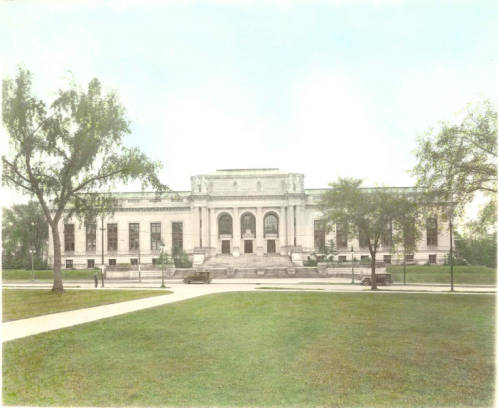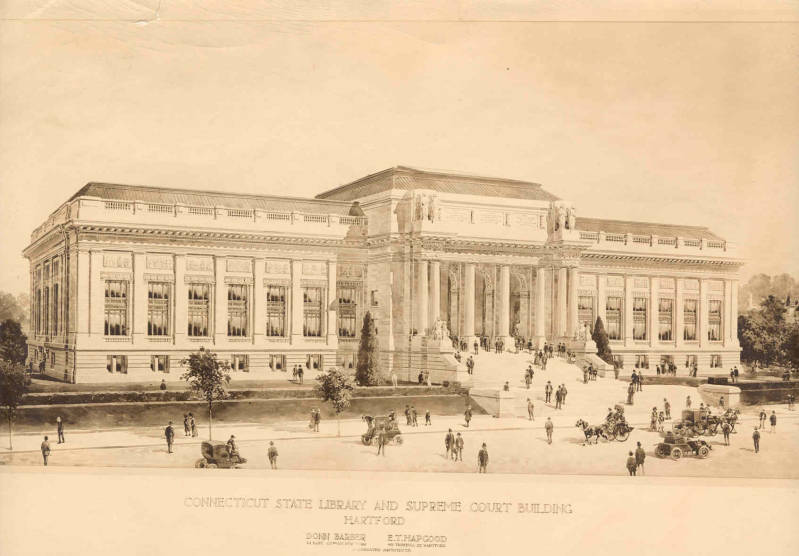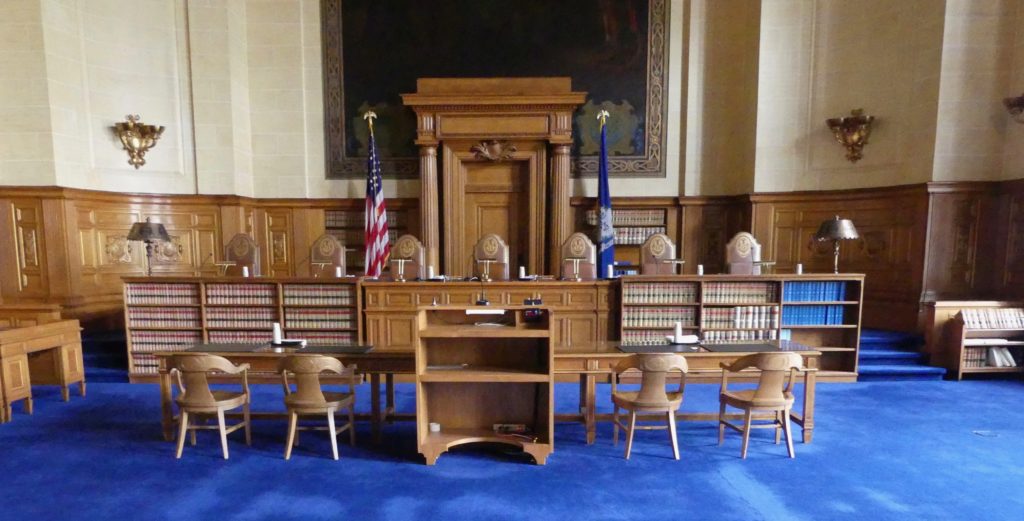By Kendall F. Wiggin
(c) Connecticut Explored Inc. Fall 2010
Subscribe/Buy the Issue!
November 28, 1910 was a big day for George S. Godard. On this day, the 10th anniversary of his appointment as Connecticut’s third state librarian, his dream of a dedicated State Library building was realized. Godard noted in his biennial report to Governor Frank B. Weeks that the “years 1909 and 1910 constitute a most important epoch in the history of the Connecticut State Library, for during this time it has been our privilege and pleasure to have seen our hopes and expectations actually materialized.” Godard had spent the better part of 10 years advocating and working toward the construction of a building “whereby all the books of the library could be brought together, where the several portraits and paintings could be properly and safely hung, where regularly constructed vaults for the invaluable records and papers might be accessible, and where rooms or special apartments for study could be provided and proper provision made for the development and work” (Report of the State Librarian, 1906).
Godard was a leader in the development of state library services. He recognized the value of new technologies and library processes, and this was reflected in many of the building’s interior features. The Beaux-Arts style of architecture, highlighted at the 1893 World Columbian Exposition (at which Godard served as a sergeant in the guide corps) and at the core of the City Beautiful movement, was the only style the Commission to Make Repairs on the Capitol and to Procure a Site for a New Building for State Officials would consider for the design competition that led to the selection of Donn Barber of New York City and Edward T. Hapgood of Hartford as the architects for the project.
The State Library was established by act of the state legislature in 1854. It was first located in the State House in Hartford (now called the Old State House) and moved to the new State Capitol building when it opened in 1878; the library occupied what now are the Senate chambers. From its beginnings space had been a concern. When the first state librarian, Dr. James Hammond Trumbull, took his post in the autumn of 1854, he found “the rooms in the upper story of the State House…appropriated to the Library, were small, badly lighted, inconvenient, of difficult access, and required extensive alterations and repairs…for even the temporary accommodation of the books…while any provision for the anticipated increase of the library seemed impossible, without change of location.” (Report of the State Librarian, 1855).
By the time the library was established, many of the state’s early manuscripts and published works had fallen into private hands. Godard was particularly aggressive in recovering these materials. The new building would greatly enhance his efforts. The safety of the collection was on of Godard’s key tenants, and he took pains to ensure that the new building be fireproof (or at least what passed for fireproof at the time). Much of what appears to be wood in the library’s main reading room, for instance, is actually faux wood grain painting on metal.
The planning of the new building was assigned to five members of the Commission through legislative action in 1903. The commissioners were powerful figures and had enormous decision-making power. The minutes (State Archives, R.G. 60) make it very clear that the Commission, along with Justice Prentice (representing the interest of the Supreme Court) and Godard, was very involved in every detail of the building, from the selection of the granite to the type of cement to the size of the building. They chose the site, purchased the various properties, and decided the building’s location on the property. On April 3, 1906 the Commission voted that the proposed gallery that would house the various gubernatorial portraits, the Charter, and the Fundamental Orders would be called “Memorial Hall” – a name that is used to this day.
On October 3, 1906 the Commission selected the proposal from Barber, a well-known architect schooled in the Beaux-Arts style. Barber developed a strong relationship with the Commission and with Godard. Ground was broken on July 29, 1908. Construction commenced on October 23, and the corner stone was laid on May 25, 1909. The publication commemorating the event noted that it was “a perfect day.” Chief Justice Simeon E. Baldwin delivered the address, noting the significance of the court’s now being in a building separate from the legislative body. Governor Weeks, the General Assembly, the Judiciary of the State, and the Grand Lodge of Ancient Free and Accepted Masons of Connecticut, which had as its special escort the Washington Commandery Knight Templars, and the three Masonic lodges of Hartford were also in attendance. The day was very much about the history of the state, patriotism, and evolution of the court. The cornerstone, six feet six inches long, three feet wide, and two feet four inches high and weighting four tons, contains a copper box holding a variety of objects — flags, coins, medals, documents, newspapers of the day, and a piece of the Charter Oak.
Built at a cost of $1.2 million, the building opened with little fanfare but to great praise. The Hartford Courant (December 17, 1910) reported it was “one of the most beautiful structures in this country.” The first session of the Supreme Court was held in the new building on January 2, 1911. Many of the decorative elements, such as the four heroic figures on the façade of the building sculpted by Francois M. L. Tonnetti and the murals by Albert Herter that adorn the Supreme Court room and Library’s main reading room were not completed for several more years. It wouldn’t be until February 11, 1914 that het Commission formally turned the building over to the state and its care to the state librarian at a ceremony in Memorial Hall presided over by now-Governor Simeon E. Baldwin. Additions were built in 1965-69 and 1974-75, but the library retains most of its original features. In 1981 it was listed on the National Register of Historic Places.
The Supreme Court and the State Library has been marking the anniversary of the building throughout 2010. On December 1, the Supreme Court plans to hold a session in the Old Statehouse, then the Capitol, and then the State Library and Supreme Court Building. There will be tours that day followed by a reception and dinner in Memorial Hall.
Kendall F. Wiggin is Connecticut’s 10th state librarian.
Explore!
Read more Historic Preservation stories on our TOPICS page.



